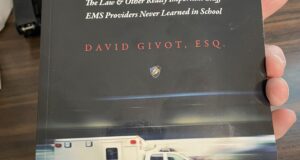I get frequent inquiries from fellow EMTs, all asking some variety of the same question: “How do I break into presenting at EMS conferences?”
Despite the overwhelming temptation to reply, “Bribery and sexual favors,” today I’ll play this one straight. What follow are some lessons I’ve learned in close to 18 years standing in front of people with a laser pointer in my hand.
- Get really good at one thing, and then talk about it. Pick a topic you’re really passionate about, and then develop a presentation about it. It helps if you’re passionate about something nobody else is talking about, or doing so poorly that you know you can do better. Once you’ve really owned a particular topic, you can try branching out. For example, one of the first couple of talks I did was how to do a 12-lead ECG (9, actually) with a 3-lead monitor. Very few others were talking about it, or if they were, they were referencing expensive machines that few EMS systems could afford at the time. Another was comparing EMS education to training Labrador Retrievers. I was the only one doing that one, and it’s still relevant today.
- Don’t get too busy with it. Have only 4-5 educational objectives for a 60 minute lecture. It’s an EMS conference lecture, not War and Peace.
- More imagery, less words. If you’re a really dynamic speaker, you can carry a lecture on pure force of personality, but almost nobody is dynamic enough to overcome the PowerPoint Wall O’ Text. You’re almost always better served by a simple captivating or humorous photo or video clip (a short one) that illustrates your point. Throw up the picture, and talk about it. If you must use bullet points, use no more than 4-5 per slide, and each point should be no more than a sentence. Treat your slides as your lecture notes and outline, not the lecture itself. The more lectures I develop, the shorter they get, and the less they can actually be described as lectures. The best presentations are interactive. A 60-minute presentation shouldn’t have more than 45 slides, and half that would be better.
- Pay attention to the quality of your materials. Make sure your photos are crisp, and your text is high contrast. Dark, bold text on a light background is fine, or yellow/white text on a darker background. Most of my slides are yellow slide titles and white text on a deep blue background, or blue text on a near-white background. A nice, EMS-themed PowerPoint template can be visually appealing, bu don’t make it too busy. When you’re using text, keep it clean and simple. Arial or Calibri font, and anything less than 24-point font is hard for many people to see. And for God’s sake, PROOFREAD. Read it a dozen times, then read it again. Then hand it to a dozen friends to proofread. Nothing is more distracting to the attendee, or embarrassing to the presenter, than a glaring spelling or grammatical error on the slide. But at the same time…
- … YOU are the star of your presentation, not the media. Keep the slide animations to a minimum, and for pity’s sake, avoid sound effects. I typically animate my objectives slide and my summary slide, and a very few others where I’m building points as I talk. In those cases, I may spend 15 minutes with a single slide on the screen, and bring up bullet points one by one. Less is more.
- Rehearse, rehearse, rehearse. If you can’t deliver your lecture cold, with your back to the screen the entire time, you haven’t practiced enough. Speak to a mirror in an empty room if you must, but rehearse.
- Be yourself. You’re not going to do a better Bob Page than Bob himself, and the people that want to hear Tom Bouthillet are already in his room. That’s why his room is full, and yours has fifty people. And it likely always will. But if you’re good enough, eventually you’ll be that guy who people go to see, no matter what he’s talking about. Watching an excellent speaker do his thing can give you all sorts of great ideas and techniques to mimic, but ultimately, you want people to attend because they came to see you. And on that note…
- Learning is best accomplished between fits of laughter. Humor is an excellent teaching tool. Crack a joke now and then. Keep it light and engaging. Be self-deprecating. Of course, you don’t want it to turn into a non-stop gigglefest with no educational value, but EMS education is far too important an endeavor to take 100% seriously. There’s a reason Bob Page calls his schtick Edutainment; It’s equal parts education and entertainment. Don’t skew too far to either side.
- Develop a thick skin. You may find this hard to believe, but at every single EMS conference, there are people who pay good money to attend, take time off to travel, and spend their days sitting in lecture halls… just to say catty things about the speakers. Believe me, they exist. They’re fundamentally unhappy people, and nothing you do will make them less miserable, or more inclined to say nice things about you. Thankfully, they’re a small minority. Pay attention to the speaker evaluations that said good things about you, and pay even greater attention to the critical, but constructive comments. They’re what make you a better speaker. Ignore the haters. One of my biggest flaws as a speaker is that sometimes my humor is a bit inappropriate. And a number of people have marveled, “Kelly, how do you get away with saying some of the things you do?” The answer is that I learned to read an audience long ago, and to know where the line is drawn. And I learned that no matter how PC and PG-rated I am, the haters are going to hate anyway. So I gleefully ignore the 2% who are offended by everything, and teach to the 98% who don’t have large sticks lodged in their rectums.
That’s pretty much it for the basis for your speaking and presentation style. In Part 2, we’ll discuss how to pimp yourself to conference committees.
 Ambulance Driver Files A Day in the Life | Kelly Grayson
Ambulance Driver Files A Day in the Life | Kelly Grayson



